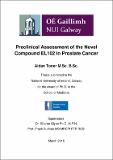| dc.description.abstract | Prostate cancer remains a growing problem for the male population, globally. Though there have been clinical advances in recent years, there still remains a need to develop drugs that can slow or stop progression beyond the organ-confined phase to distal aggressive metastases. Using the NCI-60 drug screen panel, the novel compound, EL102, was identified as a potent cytotoxin from a large screen of small molecule inhibitors. Classified as a toluidine sulphonamide, EL102 had displayed strong anti-cancer potential in the range of cell types assayed. Among these cell lines were prostate cancer models, PC-3 and DU145. These cell lines, along with fellow prostate cancer in vitro models CWR22, 22Rv1 and LNCaP were investigated further for their response to EL102 treatment. A 50 % reduction in cell viability was observed upon EL102 treatment of the in vitro panel, at a dose range of 20 alpha 50 nM. When EL102 was administered to CWR22 murine xenograft models, in combination with clinically-used docetaxel, a significant reduction in the rate of tumour growth was observed when compared to mice treated with either drug alone. Importantly, body weights remained consistent between the treatment arms, suggesting doses were well-tolerated, within this cohort. These data suggest the suitability of EL102 as a companion treatment. Separately, this study has determined that EL102 is a microtubule destabiliser that induces apoptosis.
A previous 3D-quantitative structure-activity relationship (QSAR) study of toluidine sulphonamides, predicted these compounds directly inhibit hypoxia inducible factor 1 alpha (HIF1alpha). The findings of this document support that prediction. Moreover, the current study has detailed a role for EL102 as an androgen receptor (AR) antagonist which gives credence to the rationale for use as an anti-prostate cancer therapy. In vitro investigations, detailed within this study, have also asserted that EL102 has the capacity to overcome acquired drug-resistance mechanisms associated with MDR1 and BCRP up-regulation. Overall, EL102 is a multimodal compound which serves to impede prostate cancer cell survival through direct inhibition of important cell survival cues. | en_US |


